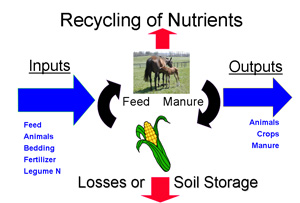Why Is It Important to Manage Horse Manure?
When managed properly, nutrients from manure should be seen as part of a larger cycle occurring on the farm. Nutrients enter the farm as feed or fertilizer, are excreted as manure, and are subsequently spread on the soil, taken up by plants, or transported off the farm as waste. Related: Horse Manure Composting: Facilities and Methods
The soil can store nutrients, provided the amount of manure applied to the soil is not excessive. When land has excess manure, more nutrients than crops can take up, these nutrients will build up in the soil and pose a hazard to ground or surface water. Excess nutrients can be carried by water through runoff or leaching to surface or ground water.
To minimize environmental risk, all horse farms should develop management plans that provide for proper storage, use, and disposal of horse manure.
What Is Nutrient Management?
The purpose of nutrient management is to implement practices that permit the efficient use of manure for crop production while preventing environmental damage that may be caused by nutrients. Nutrient management planning is a site specific exercise and, if the recommendations are followed, nutrient losses should be minimal. In general nutrient management considers how many nutrients are accumulating on a farm, their potential impacts on the environment, and how to best utilize them. Usually considered in nutrient management planning are:
- goals of the farm as well as any constraints,
- available farm resources (land, equipment, financial resources),
- potential critical areas on the farm (sensitive water bodies, neighbors concerns, erosion, manure storage etc),
- and nutrient balance (shown in the figure below).
Importance of Nutrient Balance
Farm nutrient inputs consist of feed and fertilizer, but also animals, legume nitrogen, and bedding. Farms may export nutrients through outputs such as grain, animals, milk, meat, eggs, manure, and hay. Some nutrients are recycled on the farm, from feed to livestock to soil to plant and back to feed again. The optimal situation is for the farm to remain in balance between inputs and outputs without losses either as runoff to surface water or as leachate to groundwater. For more information, see Whole Farm Nutrient Balance.
Additional Articles On Horse Manure Management
The challenges of managing manure nutrients are different on a horse farms than on many larger farms. Horse farms often have fewer animals and sometimes several animal species on the same farm, but may have limited acreage for spreading manure. Some horse farms also face a challenge because they do not export nutrients from their system the way that many other farms do–by marketing outputs such as milk or selling animals that are produced.
The following articles are available on this website and include links to additional resources for each topic.
- Stall Waste Production and Management
- Equine Barnyard Management
- Manure Storage on Horse Farms
- Spreading Manure on Horse Farms
- Off-Farm Manure Disposal
- Exercise or Sacrifice Lots for Horses
- Pasture Management on Horse Farms
- Fencing To Limit Horses Access to Riparian Areas
- [Waste to Worth proceedings and video] Reducing Hay Waste on Horse Farms
- [Waste to Worth proceedings and video] Using Composted Stall Waste as Bedding
- [Waste to Worth proceedings and video] Case Study of Herbicide Contaminated Compost
- [Waste to Worth proceedings and video] Markets for Composted Agricultural Waste
You may also want to see Nutrient Planning on Small Farms. It provides information about how to feed animals and manage their diets; calculate how much manure is produced. There is also information on basic soil science and soil fertility; and nutrient (manure) management – manure use on and off the farm and nutrient management planning.
Author: Michael Westendorf, Rutgers, The State University of New Jersey


